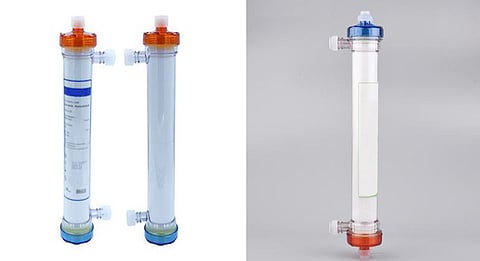Nadine Wilson
The use of renal dialysis is essential for the survival of patients whose kidneys are no longer able to filter waste and excess fluids. Dialyzers are an essential component of the dialysis process. Sometimes referred to as a "artificial kidney," the dialyzer is a device that assists the kidneys in filtering blood. Dialysis patients absolutely require dialysis machines, which is why this page will explain what they are, how they function, and the different types of dialysis machines.
Definition: Dialyzer
Hemodialysis patients utilize dialyzer to filter waste, fluids, and poisons from their blood when their kidneys fail. Kidney failure patients need the dialyzer to maintain fluid and electrolyte balance by mimicking the kidneys' filtration function. Blood flows over a semi-permeable dialyzer membrane that filters contaminants. Blood flows on one side of the membrane, and dialysate flows on the other. Blood waste and excess fluids breach the membrane and are taken away by the dialysate, leaving clean blood for the patient.
How Do Dialyzers Work?
Dialysis uses diffusion, the movement of molecules from high to low concentrations. The semi-permeable membrane in the dialyzer transfers blood waste and surplus water into the dialysate solution, which has a lower concentration.
Dialyzer operation involves two main processes:
1. Waste materials: including urea, creatinine, and excess potassium are eliminated from the blood by diffusing through the membrane into the dialysate. This procedure filters hazardous substances from the blood that the kidneys would ordinarily filter.
2. Ultrafiltration: Eliminates excess blood fluid. A pressure gradient from the dialysis machine drives blood water through the membrane into the dialysate. Kidney failure patients at danger of fluid overload need this to balance their fluid levels.
The dialyzer filters waste, balances fluids, and regulates electrolytes like healthy kidneys.
Dialyzer types
Dialyzers are created for certain dialysis patients. The two main dialyzer types are:
1. High-Flux Dialyzers: For more comprehensive waste and fluid removal, high-flux dialyzers are devised. These dialyzers remove bigger molecules efficiently due to their membranes and larger surface area. They remove a wider range of waste, making them more effective for severe renal failure.
2. Low-Flux Dialyzers: Low-flux dialyzers remove less waste and fluids due to their lower surface area and less permeable membranes. Dialyzers are used for less severe renal failure or less intense treatment.
Dialyzer Parts
A typical dialyzer has numerous essential parts that help filter. Components include:
1. Semi-Permeable Membrane: The main component of the dialyzer. The membrane is polysulfone, polycarbonate, or cellulose. It permits waste and surplus fluids to pass from the blood to the dialysate but blocks blood cells and proteins.
2. Dialysate Compartment: A distinct fluid flows in the opposite direction of blood through the dialyzer. Waste materials and surplus fluids from the membrane are absorbed by the dialysate, cleaning the blood.
3. Dialyzer housing holds: blood and dialysate compartments together and maintains pressure for optimal filtration.
Hemodialysis Dialyzer Importance
Dialyzers are essential for renal failure patients on hemodialysis. It acts as an artificial kidney, eliminating waste, poisons, and excess fluids from the blood to maintain body function.
Dialyzers are essential in kidney dialysis for these reasons:
1. Remove Waste Products When the kidneys fail, urea and creatinine build up in the blood. The dialyzer eliminates them. This keeps pollutants from accumulating and causing health problems.
2. Maintain Fluid Balance: Excess fluids can lead to edema, high blood pressure, and heart strain. Dialyzers manage fluid levels, preventing fluid overload issues.
3. Manage Electrolyte Levels: The dialyzer balances blood electrolytes such as sodium, potassium, and calcium. Muscle and nerve function depends on this, and imbalances can be hazardous.
4. Dialysis-Related Complication Prevention: Dialyzers lower the risk of kidney failure consequences such infection, cardiovascular disease, and bone damage by properly removing waste, fluids, and toxins.
Choose the Right Dialyzer for Treatment
Dialyzer selection relies on a patient's kidney function, treatment needs, and health. A doctor will examine these considerations while choosing a dialyzer for the most successful and comfortable dialysis.
Dialyzer selection factors include:
• Dialyzer Size and Weight: Larger patients may need a larger surface area for better filtration.
• For lengthier dialysis treatments: a high-flux dialyzer may be used for efficient waste removal.
• Patients with other health concerns: like cardiovascular illness, may need specific dialyzer setups for optimal outcomes.
Conclusion
Hemodialysis patients depend on the dialyzer to mimic renal filtration. Dialysis patients' quality of life improves when the dialyzer removes waste, extra fluids, and electrolytes. Understanding renal dialysis dialyzer types, components, and roles can help patients and healthcare providers choose treatments.


